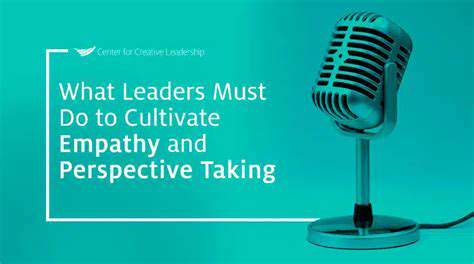Guide to Improving Your Active Listening Skills
Understanding the Core Concept
Active listening isn't simply hearing the words someone is saying; it's a multifaceted process that involves fully concentrating on what's being said, both verbally and nonverbally. It requires a conscious effort to understand not only the explicit message but also the underlying emotions, intentions, and perspectives being conveyed. This involves paying close attention to both the speaker's words and their body language, tone of voice, and even their pauses to gain a comprehensive understanding of their message.
The Benefits of Active Listening
Implementing active listening techniques can significantly enhance your communication skills and foster stronger relationships. By truly understanding and validating the speaker's perspective, you create a safe and supportive environment for open dialogue. This leads to increased trust, better problem-solving, and more effective collaboration in any setting, from personal relationships to professional environments.
Furthermore, active listening can help you anticipate potential misunderstandings and resolve conflicts more constructively. By demonstrating empathy and genuine interest, you can build stronger connections with others and cultivate a more positive and productive atmosphere.
Recognizing Nonverbal Cues
Nonverbal communication plays a crucial role in active listening. Pay attention to the speaker's body language, such as their posture, gestures, facial expressions, and eye contact. These cues can often reveal more about their true feelings and intentions than their spoken words. Understanding these nonverbal signals can help you gain a deeper understanding of the speaker's message and respond appropriately.
Empathy and Perspective-Taking
A key component of active listening is developing empathy and trying to understand the situation from the speaker's perspective. This involves acknowledging and validating their feelings, even if you don't necessarily agree with their viewpoint. Putting yourself in their shoes and considering their background, experiences, and motivations can help you understand their message more fully and respond in a way that is supportive and considerate.
Asking Clarifying Questions
To ensure complete understanding, actively ask clarifying questions. This demonstrates your interest in what the speaker is saying and allows you to gain a deeper understanding of their point of view. Avoid interrupting or formulating your response while the speaker is still talking. Instead, focus on reflecting back what you've heard to confirm your comprehension.
Providing Feedback and Summarizing
After the speaker has finished, take time to summarize what you've heard to confirm your understanding. Restate their key points and feelings in your own words. This demonstrates that you were actively listening and helps the speaker feel validated. Provide constructive feedback that demonstrates your comprehension and encourages further discussion.
Overcoming Barriers to Active Listening
Obstacles to active listening can include distractions, preconceived notions, and personal biases. Consciously work to identify and address these barriers. Create a supportive environment free of interruptions and distractions. Actively challenge your own biases and preconceived notions to ensure an objective understanding of the speaker's message. Practice patience and avoid interrupting, allowing the speaker to fully express their thoughts and feelings.
Beyond Hearing: Techniques for Enhanced Active Listening
Understanding the Multi-Sensory Approach
Active listening isn't solely about hearing words; it's a multifaceted process encompassing various sensory inputs. Recognizing nonverbal cues, such as body language, facial expressions, and even the subtle variations in tone of voice, significantly enhances our comprehension of the speaker's message. Consider the speaker's posture, their hand gestures, and the overall atmosphere they create. These subtle indicators often reveal more about the speaker's emotions and intentions than words alone, offering a deeper understanding of their perspective.
Beyond the visual and auditory, consider the environmental context. Is the speaker speaking in a distracting or supportive environment? The room's temperature, lighting, and even the presence of other people can influence the speaker's communication and, by extension, the message being conveyed. A quiet, well-lit space, for example, can foster a more focused and receptive atmosphere for both the speaker and the listener.
By actively engaging all our senses, we move beyond a simple reception of words and delve into a richer, more nuanced understanding of the speaker's message, both verbal and nonverbal. This expanded awareness enables us to respond more thoughtfully and empathetically, fostering stronger connections and more productive interactions.
Developing Empathetic and Reflective Listening Skills
True active listening transcends simply hearing the words; it involves an empathetic understanding of the speaker's perspective. This requires us to step into their shoes, imagining their feelings and motivations. We must try to understand not only what they are saying but also *why* they are saying it. This requires a degree of emotional intelligence and a genuine willingness to see the world from their point of view.
Reflective listening is a crucial component of this process. Instead of simply waiting for our turn to speak, we actively summarize and paraphrase what the speaker has said, ensuring we've accurately grasped their meaning. This demonstrates that we're engaged and encourages the speaker to clarify any misunderstandings, fostering a more collaborative and effective communication exchange. By demonstrating a genuine interest in their viewpoint, we show respect and build trust.
Furthermore, reflecting on your own biases and assumptions is essential to truly understand others. We often filter information through our own experiences and perspectives, leading to misinterpretations. Recognizing these inherent biases allows us to approach communication with a more open mind and seek a clearer understanding of the other person's viewpoint.
Developing these skills takes conscious effort and practice, but the rewards are substantial. Empathetic and reflective listening not only improves communication but also fosters stronger relationships and more productive interactions across all aspects of life.


Practicing and Refining Your Active Listening Skills
Understanding the Core Components of Active Listening
Active listening isn't just about hearing the words someone says; it's a multifaceted process encompassing several crucial components. A key aspect involves focusing intently on the speaker, both verbally and nonverbally. This means maintaining eye contact, nodding, and using other nonverbal cues to signal engagement. It also requires understanding the speaker's emotional tone and the underlying message beneath the surface of their words. This deep understanding goes beyond simply deciphering the literal meaning and delves into the speaker's feelings and motivations, creating a genuine connection.
Another vital component is reflecting on what the speaker is saying. This involves paraphrasing, summarizing, and asking clarifying questions. Paraphrasing helps to ensure you've grasped the core message accurately. Summarizing allows you to condense the main points, making it easier to retain information and demonstrating that you're actively processing what's being communicated. Strategic questioning helps to confirm your understanding and invites the speaker to elaborate on specific points, fostering a more thorough and productive dialogue.
Strategies for Enhancing Your Active Listening Skills
Developing active listening skills requires consistent practice and conscious effort. One effective strategy is to create a conducive environment for communication. Minimize distractions, such as turning off your phone or finding a quiet space to engage in conversation. Actively focusing on the speaker and their message is crucial. This means putting aside your own thoughts and concerns and giving your undivided attention to the person speaking.
Practice empathy, putting yourself in the speaker's shoes to understand their perspective. Try to see the situation from their point of view, acknowledging their feelings and motivations. This empathetic approach will help you connect more deeply and understand their message more completely. Remember that active listening is an ongoing process of learning and refinement, and consistent practice is key to improving this valuable skill.
Another useful technique is to avoid interrupting or formulating your response while the other person is still speaking. Allow them to fully express their thoughts and feelings without feeling rushed or judged. This creates a safe space for open communication and fosters trust and respect in the interaction.
Finally, actively acknowledging the speaker's feelings and validating their experiences can significantly enhance the quality of communication. This can be done by offering supportive statements or mirroring their emotions. This builds trust and rapport, enabling a more profound understanding of the message being conveyed.
Regularly practicing these strategies will gradually improve your active listening skills, resulting in stronger relationships and more productive interactions with others.
Hot Recommendations
- The Science Behind Ceramides in Skincare
- How to Fix a Broken Nail Quickly
- How to Improve Your Listening Skills for Better Communication
- How to Use Body Language to Build Trust
- The Role of Scent in Personal Image
- Best Affordable Vitamin C Serums [2025]
- Best Affordable Eyeshadow Palettes [2025]
- Guide to Caring for High Porosity Hair
- Grooming Tips for Your Clothes [Maintenance]
- Grooming Tips for Your Feet [Essential Care]










